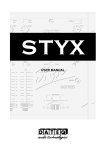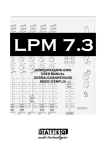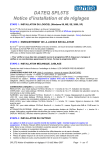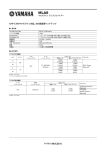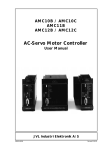Download Dateq Apollo User manual
Transcript
APOLLO USER MANUAL Safety instructions 1 All safety instructions, warnings and operating instructions must be read first. 2 All warnings on the equipment must be heeded. 3 The operating instructions must be followed. 4 Keep the operating instructions for future reference. 5 The equipment may never be used in the immediate vicinity of water; make sure that water and damp cannot get into the equipment. 6 The equipment may only be installed or fitted in accordance with the manufacturer's recommendations. 7 The equipment must be installed or fitted such that good ventilation is not obstructed in any way. 8 The equipment may never be installed in the immediate vicinity of sources of heat, such as parts of heating units, boilers, and other equipment which generates heat (including amplifiers). 9 Connect the equipment to a power supply of the correct voltage, using only the cables recommended by the manufacturer, as specified in the operating instructions and/or shown on the connection side of the equipment. 10 The equipment may only be connected to a legally approved earthed mains power supply. 11 The power cable or power cord must be positioned such that it cannot be walked on in normal use, and objects which might damage the cable or cord cannot be placed on it or against it. Special attention must be paid to the point at which the cable is attached to the equipment and where the cable is connected to the power supply. 12 Ensure that foreign objects and liquids cannot get into the equipment. 13 The equipment must be cleaned using the method recommended by the manufacturer. 14 If the equipment is not being used for a prolonged period, the power cable or power cord should be disconnected from the power supply. 15 In all cases where there is a risk, following an incident, that the equipment could be unsafe, such as: • if the power cable or power cord has been damaged • if foreign objects or liquids (including water) have entered the equipment • if the equipment has suffered a fall or the casing has been damaged • if a change in the performance of the equipment is noticed it must be checked by appropriately qualified technical staff. 16 The user may not carry out any work on the equipment other than that specified in the operating instructions. Apollo: A Giant Leap For Mankind... 15 20 12 9 -6 Mic Mic Phono Phono Phono Line 1 Line Line Line Line Line Line 2 GAIN 15 20 0 30 3 z 0 -1 2 z -1 2 3 2 1+ MID 2 3 2 3 4 5 -1 0 2 2 5 5 MASTER A A 2 2 2 5 5 MASTER B A A -1 2 A 2 0 5 -1 2 3 A 20 A B PFL PFL PFL PFL 2 dB 3 3 7 8 1 9 0 +6 +6 +6 +6 +6 +3 +3 +3 +3 +3 0 0 0 0 0 0 -3 -3 -3 -3 -3 -3 -6 -6 -6 -6 -6 -6 -9 -9 -9 -9 -9 -9 -12 -12 -12 -12 -12 -12 -20 -20 -20 -20 -20 -20 -30 -30 -30 -30 -30 -30 -40 -50 -40 -50 -40 -50 -40 -50 -40 -50 -40 -50 10 SPLIT Master +3 5 6 PFL 5 2 R PFL +6 0 1R BAL 4 5 4 50 PFL 3 +6 4 40 MASTER 0 z 2 30 L PFL -6 3 4 5 5 MASTER B 12 9 L1 3 4 5 5 MASTER B PFL 2 3 4 3 +6 30 5 0 1+ LOW 2 3 4 10 4 MON 0 z 15 20 3 4 -6 30 -5 0 1+ MID 2 3 5 1+ LOW 2 3 -1 3 +6 12 9 15 20 0 3 EFFECT 0 z 3 5 -6 30 4 5 1+ MID 2 +6 +6 0 1+ HIGH 2 4 4 5 -1 4 2 12 9 15 20 0 3 3 5 5 MASTER B -1 4 2 4 z 1+ HIGH 2 3 GAIN 3 5 0 -6 30 3 5 1+ LOW 2 5 5 MASTER B 1+ MID 2 15 20 4 POWER Line 2 12 9 +6 4 5 3 4 2 3 0 0 3 4 5 -1 3 4 -1 4 2 3 4 2 5 0 1+ LOW 2 3 4 z 1+ HIGH 2 3 GAIN 3 5 0 -6 0 +6 3 -1 12 9 30 4 5 3 5 -1 0 4 4 15 20 0 2 0 1+ MID 2 4 GAIN 3 5 3 5 1+ LOW 3 4 5 5 MASTER B 0 -1 3 -1 -6 3 z 4 5 12 9 30 +6 0 1+ HIGH 2 4 3 5 -1 3 4 2 4 15 20 0 3 1+ MID 2 4 2 3 4 2 5 0 1+ LOW 2 3 4 -1 3 4 5 -1 z 5 0 GAIN 3 1+ HIGH 2 3 -1 -6 30 4 5 12 9 +6 4 3 4 5 1+ LOW 3 2 5 3 4 0 3 0 1+ MID 2 15 20 3 -1 3 -1 GAIN 0 z 4 5 -6 30 +6 0 1+ HIGH 2 4 5 0 15 12 9 20 0 3 4 -1 GAIN 3 1+ HIGH 2 4 -6 30 +6 3 5 12 9 Line 1 Monitor PHONES PP Controlled TEMPO BEATCOMPARE SYNC A B ON TRANSFORM z z z z z z The Apollo has been designed specifically for the use in clubs etc. and has two microphone-, three turntable- and two line inputs. All channels are switchable to an extra stereo line-input. The master has a stereo effect return input. This makes the Apollo a 14 input, 7 channel mixing console. Each channel has a gain-control and a 3-way equaliser. With the (A/ MASTER/ B) routing select switch every channel can be sent directly to the master output or to the crossfader inputs A or B, giving much more creative possibilities. With this feature you are totally free to select which channels to ‘crossfade’. A special tool called ‘BeatCompare’ helps you creating the perfect mix. A connected amplifier is protected against on- and off switching ‘blobs’ by means of output relays on the master and monitor outputs. Product support For questions about the Apollo, accessories and other products, please contact: Dateq Audio Technologies B.V. De Paal 37 1351 JG Almere, The Netherlands Telephone: Fax: E-mail: Internet: +31 36 5472222 +31 36 5317776 [email protected] www.dateq.nl Mounting the Apollo The Apollo can be used as stand-alone or built-in (mounted). The housing fits in an opening of 448 x 337 x 115mm (W x H x D). See also the drawings below. When mounting reckon with the extending of the connectors on the backside of the Apollo. L 1 = gnd 2= + 3= - R BALANCED MASTER 115mm 230V~AC OUT MON REC 0dB 600Ω 0dB 600Ω 0dB 600Ω EFF SENDS 155mV R R R 1R L L L 2L MONO SUB LIGHTSHOW < 125Hz Transformer coupled Made in Holland by FUSE FUSE 315mA ø 5 x 20mm slow RETURN Mono 0dB CAUTION: Risk of electrical shock. Do not open. Serial No.: LINE 1 155mV RE Apollo Connectorboard The connections for all audio in- and outputs are situated at the backside of the Apollo. The mains inlet and the fuse are also located here. L 1 = gnd 2= + 3= - R OUT BALANCED MASTER 230V~AC MON REC 7 EFF 6 5 4 3 2 0dB 0dB 0dB SENDS RETURN LINE 1 LINE 2 LINE 1 LINE 2 PHONO LINE PHONO LINE PHONO LINE 600 Ω 600 Ω 600Ω Mono 0dB 155mV 155mV 155mV 155mV 155mV 3mV / 47kΩ 155mV 3mV / 47k Ω 155mV 3mV / 47k Ω 155mV R R L L MONO SUB R 1R L 2L LIGHTSHOW R R R R R L L L L L REMOTE REMOTE REMOTE REMOTE REMOTE 1 MIC -54dB / 600 Ω LINE LINE 155mV 155mV R L REMOTE Made in Holland by F USE FUSE 315mA ø 5 x 20mm slow < 125Hz Transformer coupled Serial No.: CAUTION: Risk of electrical shock. Do not open. L / R Balanced Master Outputs (XLR 3-pins male) Pin 1 2 3 Function Audio GND Audio + Audio - Type A-GND Out Out Out / Mon / Rec Stereo Outputs & Effect Send 1 / 2 Mono Output (Cinch female) Pin Tip Shield Function Audio + Audio GND Type Out A-GND Mono Sub / Lightshow Outputs (TRS Jack 3p) Pin Tip Ring Sleeve Function Audio Audio GND Type Out A-GND Phones Output (TRS Jack 3p) Pin Tip Ring Sleeve Function Left Right Audio GND Type Out Out A-GND Phono / Line / Line 1 / Line 2 / Effect Return Stereo Inputs (Cinch female) Pin Tip Shield Function Audio + Audio GND Type In A-GND Balanced Mic Input (XLR 3-pins female) Pin 1 2 3 Function Audio GND Audio + Audio - Type A-GND In In MIC -54dB / 600 Ω R L REMOTE Connections MASTER L / R Electronically balanced master outputs for the left and right channel on XLR connectors. This type of output guarantees a perfect signal transport even when long audio cables are being used. These outputs are equipped with relays to prevent audible ‘blobs’ on connected equipment when the Apollo is switched on or off. OUT Unbalanced master output on cinch-connectors. Can be used to connect the Apollo to an amplifier or a recorder. MON Unbalanced monitor output on cinch connectors. Can be used to connect a second amplifier with monitor speakers for the DJ or a second room. REC Unbalanced recorder output on cinch-connectors. This output is fixed-level (independent from the master volume control). MONO SUB Unbalanced low-frequency output on jack connector. On this output only signals with a frequency below 125 Hz are present. Extra amplifiers for lowspeakers can be connected here. LIGHTSHOW Unbalanced mono master output on jack-connector. This output is transformer isolated from the mixer. You can connect external light control equipment safely by using this special output. EFFECT SENDS Mono pre- or postfader sends from channel 1 and channel 2. EFFECT RETURN Stereo effect return input. Can also be used as an extra input. CHANNELS 7..3 Cinch connectors for all stereo channels. Channel 7 and 6 have two identical line inputs. Channels 5..3 have both an input for turntables (Phono) and an input for equipment like CD-players, samplers, keyboards and recorders (Line). When turntables are being used, these must be earthed by means of the earth-clamp. CHANNELS 2..1 Electronically balanced microphone input on XLR connector. When used unbalanced, connect pen 1 and 3 with the shielding of the cable. Both channels are equipped with a secondary stereo line input. REMOTE On all channels an optional remote start connector can be delivered. As soon as the fader of the concerning channel is opened, the contact between tip and ring of this mini jack (3,5 mm) connection is made. With this the connected equipment can be remote started. The remote-connection is NOT suitable for switching mains voltage! FUSE Mains fuse. Dimension 5x20mm (small), 315mA slow. MAINS Euro-style mains inlet. Before connecting the Apollo for the fist time, check if your Apollo is meant for the mains voltage in your country (label on the connector board at the rear). For all cinch-connectors: White = Left, Red = Right. Microphone / Line Channels (1 and 2) These two channels have been designed to connect microphones. They are equipped with an input selector, volume control, a 3-way tone control optimized for voice, crossfader routing selector and pre-fader listening. Mic / Line Input selector. Normally the Mic input is selected. Pushed in is Line (CD, MD, tape). LEDs indicate which input is selected. GAIN Determines the pre-adjustment of the volume for both the Mic as well as the stereo Line input. HIGH High tones control. MID Mid tones control. LOW Low tones control. A / MASTER / B Signal-routing selector. When switched to A, the signal goes via the A-side of the crossfader (left LED is lit) to the master output. In position B, the signal goes via the B-side of the crossfader (right LED is lit) to the master output. In the MASTER position, the signal goes directly to the master. PFL Switches pre-fader listening on and off. When this function is active, the headphone will switch to PFL and the input signal of one or more inputs can be heard even though the fader is closed. A LED will indicate whether the PFL-function on this channel is active. When no PFL has been selected on any channel, the master signal can be heard via PFL. FADER 100 mm fader through which the volume of this channel can be determined precisely. The volume of a channel is also controlled by the crossfader if the channel is routed to the A- or B-side of the crossfader. Turntable / Line Channels (3 , 4 and 5) These three stereo channels each have two inputs (Phono for turntables and Line for equipment like CD-players and MD-recorders), volume control, 3-way tone control, crossfader routing selector and pre-fader listening. Phono / Line Input selector. Normally the Phono input is selected. Pushed in is Line (CD, MD, tape). LEDs indicate which input is selected. GAIN Determines the pre-adjustment of the volume for both the Phono as well as the stereo Line input. Dual Line Channels (6 and 7) These channels have an input selector for the two identical stereo line inputs (for equipment like CDplayers and MD-recorders), volume control, 3-way tone control, crossfader routing selector and prefader listening. Line 1 / Line 2 Input selector. Normally the Line 1 (CD, MD, tape) input is selected. Pushed in is Line 2. LEDs indicate which input is selected. GAIN Determines the pre-adjustment of the volume for both the Line 1 as well as the Line 2 input. Crossfader and Transform PP Controlled TEMPO A BEATCOMPARE SYNC B ON TRAN SFORM Normally all channels are mixed directly to the master output (with the A/ MASTER/ B-switch in the centre position). However, the channels can also be sent via the A- or B-side of the crossfader to the master. Channels via the A-side cannot be heard with the crossfader in the outmost right position. Channels via the B-side cannot be heard with the crossfader in the outmost left position. The crossfader curve can be adjusted with the trimmer. LEDs A and B above the crossfader indicate if the signal is switched to the A-side or the B-side of the cross-fader with a crossfader routing select switch. This avoids mistakes, because you can see immediately if there has been a channel selected on both sides. With the transform ON-switch pushed in (the transform ON-LED lights up), both the A- and the B-side of the crossfader will not be heard on the master output. Both crossfader-signals will now only be passed on if the transform-switch is pushed in. In this way short fragments can be made audible in a very simple way. BeatCompare The BeatCompare microprocessor is a tool for synchronised mixing music. The signal on the A and the B side of the crossfader is continuously searched for the presence of a beat. For this you have to set the signal level which is transferred to the crossfader at approximately 0dB (on PFL) and open the fader. Indication on the BEAT/CROSSFADER-LED's: • Continuously off There is no channel routed to this side of the crossfader with a routing-select-switch. • Continuously on At least one the channels is routed to this side of the crossfader and the BeatCompare processor is receiving not enough audio signal. • Blinking There is enough signal on this side of the crossfader. If a beat is found, the LED will blink along with the beat of the music. If the LED is blinking irregular, no reliable beat has been found. The indication is then not reliable. The processor indicates on the adjust LED's (inside the up- and down triangles) which source and how the speed of this source has to be adjusted. For this, the position of the crossfader and the tempo of the beats of the signal on the A- and B-side of the crossfader are taken into account. Is the fader in the left position (A can be heard), then the adjust indication of B is active. Is the fader in the right position (B can be heard), then the adjust indication of A is active. The LED in the arrow upwards indicates that the tempo has to be faster. The matching record has to be played faster. The LED in the arrow downwards indicates that the tempo has to be slower, so the matching record has to be played slower. When the signals both have the same tempo (even amount of Beats Per Minute), the tempo LED will illuminate. When both signals have the same tempo, the beats can still be incompatible. The adjust indication will than indicate which record has to be slowed down or accelerated to get compatible beats. When the beats are synchronous, the sync LED will light up. Now synchronized crossing using the crossfader is possible. Effect Sends (Channel 1 and 2) The channels 1 and 2 (Mic 1 and Mic 2) both have a mono effect send output which can be used to provide a signal for effect equipment like reverbs and echoes. Default, the effect sends are post-fader: the signal level depends on the position of the fader. Pre-fader means the signal is fixed, not affected by the fader. With jumpers (situated on the Apollo main board), you can select a pre- or postfader (see drawing) signal for both effect send outputs. Master section The master section has volume controls for the various outputs of the Apollo and a 2 x 40 segments LED-bar meter which precisely indicates the Master, Monitor or PFL signal level. POWER Mains power switch. EFFECT Volume control for the stereo effect-return input. MON Volume control for the unbalanced stereo Monitor output. MASTER Volume control for the balanced stereo Master, the unbalanced stereo Out- and unbalanced mono Sub outputs. PFL-led This LED lights up if the PFL-function is not active and the master signal is audible on the PHONES output. BAL Determines the balance between the left and the right channel. When in mid-position, the left and right channel can be heard evenly loud. PFL-knob Volume control for the headphone output. SPLIT Determines the use of the headphone when PFL is activated. Normally only the stereo PFL signal can be heard. When SPLIT is active (LED lights up) PFL can be heard on the right side of the headphone, the Master signal can be heard on the left side of the headphone. PHONES Stereo headphone output. Meter section LAMP BNC-connector for an optional gooseneck lamp (12 V, max 3 W). METER 2 x 40 segments LED-indication of the Master, Monitor or PFL level. An operation level of approximately 0dB is normal. Master/Monitor This switch selects the signal that is indicated by the meter. Each time it is pressed, the meter toggles between the Master and Monitor signal. The currently selected signal is indicated by LEDs. Technical specifications MONO INPUT MIC (channel 1 and 2)........................................ XLR-3 female, electronically balanced Signal level ............................................... -54 dB @ 600 ohm variable Impedance................................................ 3 kohm nominal Input noise................................................ <-107 dB (IHF-A) Headroom ................................................ +20 dB STEREO INPUTS PHONO (channel 3, 4 and 5) ............................. Cinch Signal level ............................................... -42 dB @ 47 kohm variable Input impedance ....................................... 47 kohm/ 25pF nominal Input noise................................................ > -80 dB (IHF-A) Channel separation................................... > 65 dB @ 1 kHz LINE (channel 1..7) / EFFECT RETURN .......... Cinch Signal level ............................................... -14 dB @ 600 ohm variable Input impedance ....................................... 22 kohm nominal Input noise................................................ > -80 dB (IHF-A) Channel separation................................... > 65 dB @ 1 kHz TONE CONTROL EQUALISER MIC High.......................................................... 10 kHz ±15 dB, Shelving Mid ........................................................... 1400 Hz ±12 dB, Bell Low........................................................... 80 Hz ±15 dB, Shelving EQUALISER LINE High.......................................................... 12 kHz ±15 dB, Shelving Mid ........................................................... 1400 Hz ±12 dB, Bell Low........................................................... 50 Hz ±15 dB, Shelving OUTPUTS BALANCED MASTER (XLR)............................ +6 dB balanced/ 600 ohm/ variable MASTER OUT / MONITOR (Cinch) ................. 0 dB unbalanced/ 600 ohm/ variable RECORDER (Cinch) ......................................... 0 dB unbalanced/ 600 ohm/ fixed level MONO SUB (6,3 mm TRS Jack) ...................... 0 dB unbalanced/ 600 ohm/ < 125 Hz LIGHTSHOW (6,3 mm TRS Jack) .................... 0 dB unbalanced/ 10 kohm/ transformer isolated MONO EFFECT SEND 1 / 2 (Cinch) ................ 0 dB unbalanced/ 600 ohm/ pre- or postfader PHONES (6,3 mm TRS Jack)........................... 0,3 W @ 4 ohm/ Impedance 4..32 ohm FREQUENCY RESPONSE MIC TO MASTER ............................................. 80 Hz...25 kHz -1 dB ALL OTHER INPUTS TO MASTER................. 20 Hz...25 kHz -1 dB THD + N ............................................................ 0,05 % nominal (CCIR-RMS) GENERAL POWER SUPPLY Mains voltage........................................... 220...240 VAC / 50 Hz Power consumption.................................. 20 W Lamp connection...................................... BNC 12 VDC / 3 W SIZE AND WEIGHT Front......................................................... 483 x 355 mm (W x H) = 19”, 8HE Cutout....................................................... 448 x 337 mm (W x H) Depth........................................................ 115 mm Weight ...................................................... 6,0 kg Net.











